
Oil & Gas Program
On This Page
New Mexico Rig Count:
97 (as of 01/05/2024)
Data from: Baker Hughes North America Rig Count
Importance of Oil & Gas in New Mexico
New Mexico has been a major producer of oil and natural gas since hydrocarbons were first discovered in the state during the early 1920's. In 2016, New Mexico produced 145 million barrels of oil, 1.27 trillion cubic feet of natural gas, and 97 billion cubic feet of naturally occurring carbon dioxide. These valuable commodities are obtained from more than 2,000 oil and gas fields. In recent years the State of New Mexico derived more than 25% of its general fund revenues from taxes and royalties on oil, natural gas, and carbon dioxide production. These taxes and royalties have contributed more than 90% of the principal in the Severance Tax and Land Grant Permanent Funds, the earnings on which are used to fund education and other state government operations. Other petroleum tax receipts are placed directly in the state's general budget. In addition, more than 11,000 citizens of this state are directly employed by the oil and gas industry. The oil and gas industry, while primarily occupying the sparsely populated southeast and northwest areas of New Mexico, is a lynchpin of the state's economy and is fiscally essential.
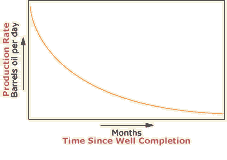 Oil and gas wells do not produce at a constant rate. As soon as a well
is drilled for oil or natural gas, the rate of production begins to
decline, as shown in the graph located below this text box. Production
rates within the state can only be sustained through ongoing exploration
and drilling programs. Because of this, the New Mexico Bureau of Geology
and Mineral Resources (NMBGMR) undertakes several types of
research and service projects that are aimed at providing ideas and
information to help sustain production in the state.
Oil and gas wells do not produce at a constant rate. As soon as a well
is drilled for oil or natural gas, the rate of production begins to
decline, as shown in the graph located below this text box. Production
rates within the state can only be sustained through ongoing exploration
and drilling programs. Because of this, the New Mexico Bureau of Geology
and Mineral Resources (NMBGMR) undertakes several types of
research and service projects that are aimed at providing ideas and
information to help sustain production in the state.
From original discovery in 1924 annual New Mexico oil production peaked at 129 million bbls per year in 1969 and then settled into a long decline that was ameliorated in the 1980's and 1990's by the discovery of new trends in the Permian Basin, redevelopment of underdeveloped fields, and implementation of enhanced recovery projects in existing, older fields. The recent upswing in oil production has been due to horizontal drilling and adaptation of hydraulic fracturing methods to horizontal wells in unconventional deep basinal reservoirs in southern Eddy and southwestern Lea counties. The result of this activity was a new annual peak for oil production at 147 million bbls in 2015, 14% more than old production high in 1969.
The Bureau Oil & Gas Program
The Oil & Gas Program at the Bureau of Geology revolves around three main efforts:
- Research in the non-producing frontier basins of the state. Several of these frontier areas, although presently nonproductive and poorly explored, have many geologic characteristics in common with producing basins and may represent a part of future oil and gas production.
- Research in producing basins, particularly the Permian Basin of southeast New Mexico and the San Juan Basin of northwest New Mexico. A large part of this effort has involved the study of reservoir characteristics of underdeveloped fields, petroleum source rocks and petroleum systems in the Permian Basin, and the Mancos Shale in the San Juan Basin.
- The New Mexico Library of Subsurface Data and the Core Library. These are publicly accessible repositories for oil and gas data that are invaluable in the search for new reserves as well as in obtaining an understanding of subsurface geology for many non-petroleum related endeavors such as the study of deep brackish-water and saline aquifers, fresh water resources, and geothermal energy potential.
In addition, our petroleum geology staff has provided substantial effort in educational programs at New Mexico Tech with activities including teaching classes, acting as research advisors to graduate students, sitting on graduate thesis committees, and mentoring geology and engineering students including those enrolled in the Petroleum Engineering senior design class.
Frontier Basin Research
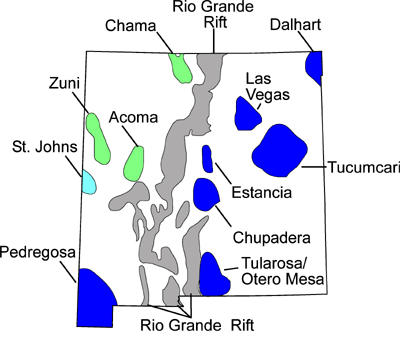
There are many examples in New Mexico where basins of different ages overlap, thus not all basins or other areas with exploration potential are shown here. This is a list of basins and areas that have attracted exploration activities by the private sector and lists of our publications and reports that pertain to these basins and areas. Perhaps more importantly, research activities in frontier basins have been aimed at developing an understanding of the geology of these basins which is often not well understood, especially in the subsurface. Development of basic geologic understanding is helpful for many non-petroleum related activities such as deep saline and brackish groundwater assessments and the understanding of geothermal energy potential.
- Chama Basin (Rio Arriba County)
- Albuquerque Basin (Bernalillo, Sandoval, Socorro, Valencia Counties; Memoir 33) and other Rio Grande Rift basins
- Zuni/Gallup Basin (McKinley, Cibola Counties; Open-file report 470)
- St. Johns CO2 area (Catron County; Open-file report 514)
- Jornada Del Muerto Basin (Socorro County)
- Acoma/Lucero Basin (Cibola, Socorro, Catron Counties)
- Pedregosa Basin (Hidalgo, Grant Counties; Circular 176)
- Devonian shales in southern New Mexico basins (Open-file reports 484, 485)
- Las Vegas Basin (Mora and San Miguel Counties; Memoir 48, Open file report 510)
- Dalhart Basin (Union County)
- Tucumcari Basin (Guadalupe, Quay, Curry, San Miguel Counties; Bulletin 119, Circular 193, Open-file report 460)
- Sin Nombre area - the divide between the Tucumcari and Permian Basins (Open-file report 467)
- Estancia Basin (Torrance County; Bulletin 157)
- Tularosa/Orogrande Basin/Otero Mesa Area (Otero County; Circular 198)
- Chupadera Mesa area of Socorro and Lincoln Counties, including the Carrizozo Basin (Open-file report 478)
Producing Basins Research
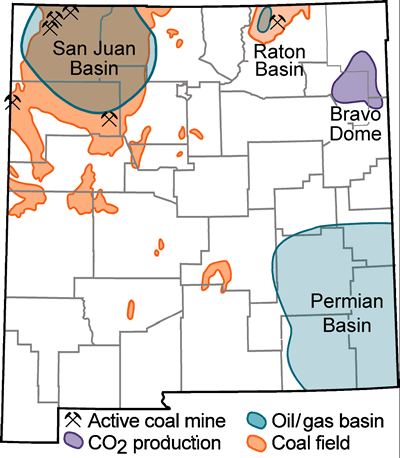
- The Mancos Shale in the San Juan Basin.
- Play Analysis and Digital Portfolio of Major Oil Reservoirs in the Permian Basin (in cooperation with the Texas Bureau of Economic Geology) . Open-file report 479 summarizes the oil reservoirs and plays in the New Mexico part of the basin. Texas Bureau of Economic Geology Report of Investigations 271 summarizes the project results for the entire basin.
- Oil and natural gas potential of the Secretary of the Interior's Potash Area, Eddy County, New Mexico (Permian Basin).
- Underdeveloped oil fields in upper Pennsylvanian and Permian carbonate reservoirs, Permian Basin (references)
- Risk reduction in petroleum exploration with a fuzzy expert system. This project has resulted in Open-file report 485 on Silurian reservoirs of the Wristen Formation and source rocks of the Devonian Woodford Shale in the New Mexico part of the Permian Basin.
- New Mexico Oil & Gas Pool maps and Morrow Play Database (Circular 209)
- San Juan Basin 20-year Reasonable Foreseeable Development (Open-file report 463)
- Bravo Dome CO2 field research
Other Oil & Gas Research
- Atlas of Major Rocky Mountain Gas Reservoirs: Description of 66 major gas plays and 861 major gas-producing reservoirs in New Mexico, Colorado, Utah, and Wyoming. Funded by Gas Research Institute and U.S. Department of Energy. Prepared in cooperation with geological surveys of Colorado, Utah and Wyoming, and Barlow and Haun, Inc., Intera-Bergeson, Inc., and Methane Resources Group.
- New Mexico Petroleum Source Rock Project: Joint Bureau-Industry project. Analyzed petroleum source rocks in more than 100 key exploratory wells throughout New Mexico. CD-ROM database completed (Digital Database DB2). Additional data area available through separate Open-file reports that either cover analyses on single wells or analyses done for larger basin-wide or regional projects. Contact Ron Broadhead for more information.
- Evaluation of Mineral and Energy Resources of McGregor Range, Otero County, New Mexico: Evaluated the mineral and energy resources of the McGregor bombing and artillery range which covers 1,000 square miles in Otero County. Funded by U.S. Army Corps of Engineers through TRC-Mariah, Inc.
- Evaluation of Mineral Resources at the WIPP site, Eddy County, New Mexico: Evaluated the oil, natural gas, and potash resources within the boundaries of the Waste Isolation Pilot Plant (WIPP) site. Funded by the Waste Isolation Division of Westinghouse Electric Corp. Oil and gas resources at the WIPP site are described in Circular 206.
- Carbon Dioxide rich gases: Identify and research accumulations of naturally occurring carbon dioxide in New Mexico. Carbon dioxide produced from these accumulations is used for enhanced oil recovery in the Permian Basin. Contact: Ron Broadhead .
- Helium gases in New Mexico - geologic distribution, models for exploration, and exploration possibilities (Open-file report 483 covers the entire state; Open-file report 478 covers the Chupadera Mesa area). Contact Ron Broadhead .
New Mexico Subsurface Data & Core Libraries
These libraries are a valuble resource for anyone interested in subsurface geology in New Mexico. Please visit the library page for more information.
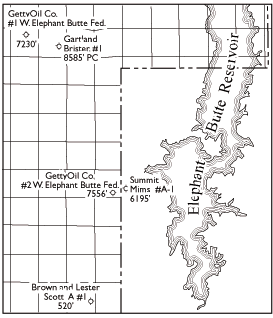
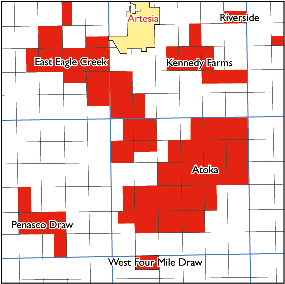
Oil & Gas Publications
The New Mexico Bureau of Geology and Mineral Resources publishes a wide variety of geologic literature for both the professional geologist and the layman. Some publications concerning oil and gas are listed below. Please visit Ron's publications page where many of our publications are listed by basin and other topical areas.
- New Mexico's energy, present and future: policy, production, economics, and the environment, Decision-Makers Field Conference Guidebook by Brister, B. S., and Price, L. G., eds., 2002, 152 p.
- New Mexico oil and gas pool maps with an additional emphasis on the Morrow play, Circular 290 by Read, A., Broadhead, R., Lopez, A., Fleming, E., Watrous, J., Rewis, A., Brister, B., 2000, 1 CD-ROM.
- New Mexico petroleum source rock database, Digital Data Series DDS DB2 by R. F. Broadhead, M. Wilks, M. Morgan, and R. E. Johnson, 1998, 1 CD-ROM.
- Subsurface geology and oil and gas potential of Estancia Basin, New Mexico, Bulletin 157 by R. F. Broadhead 1997, 53 p.
- Coalbed methane in the Upper Cretaceous Fruitland Formation, San Juan Basin, New Mexico and Colorado, Bulletin 146, edited by W.B. Ayers, Jr., and W.R. Kaiser, 1994, 216 p.
- Atlas of major Rocky Mountain gas reservoirs, by New Mexico Bureau of Geology and Mineral Resources et al., 1993, 206 p. Large atlas format, with database on diskette and 10 oversize sheets.
- Future petroleum provinces in New Mexico: discovering new reserves, by P. R. Grant, Jr., and R. W. Foster, 1989, 94 p., large atlas format.
- Lower and Middle Pennsylvanian strata in the Orogrande and Pedregosa Basins, New Mexico, Bulletin 124, by J.L. Wilson, 1989, 16p.
- The story of oil in New Mexico, Scenic Trip to the Geologic Past No. 14 by P. W. Christiansen, 1989, 112 p. This is a fun-to-read history of the early days of oil in New Mexico.
- Petroleum geology of Pennsylvanian and Lower Permian strata, Tucumcari Basin, east-central New Mexico, Bulletin 119 by R. F. Broadhead and W. E. King, 1988, 75 p.
- Oil and gas potential of the Tularosa Basin ñ Otero platform ñ Salt Basin graben area, New Mexico and Texas, Circular 198 by W. E. King and V. M. Harder, 1985, 36 p.
- Subsurface petroleum geology of Santa Rosa Sandstone (Triassic), northeast New Mexico, Circular 193 by R.F. Broadhead, 1984, 22 p.
- Stratigraphically controlled gas production from Abo red beds (Permian), east-central New Mexico, Circular 183 by R.F. Broadhead, 1984, 36 pp.
- Porosity zones of lower part of San Andres Formation, east-central New Mexico, Circular 179 by W.D. Pitt and G.L. Scott, 1981, 19 p.
- Pennsylvanian stratigraphy, petrography, and petroleum geology of Big Hatchet Peak section, Hidalgo County, New Mexico, Circular 176 by S. Thompson III and A.D. Jacka, 1981, 125 p.
- Model for beach shoreline sedimentation in Gallup Sandstone (Upper Cretaceous) of northwestern New Mexico, Circular 164 by C.V. Campbell, 1979, 32 p.
- Hydrocarbon potential of pre-Pennsylvanian rocks in Roosevelt County, New Mexico, Circular 130 by W.D. Pitt, 1973, 7 p.
- Geology of Pennsylvanian and Wolfcampian rocks in southeast New Mexico, Memoir 17 by R.F. Meyer, 1966, 123 p.
- Preliminary investigations of the oil shale potential in New Mexico,
Circular 87 by R.W. Foster, P.B. Luce, L.G. Culver, and B.B. Maras,
1966, 22 p.
The above publications can be ordered by contacting our Publications Office.



